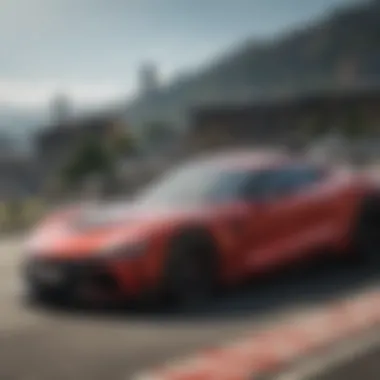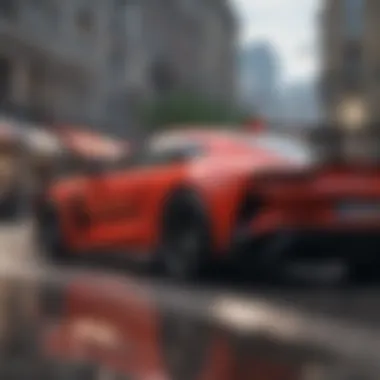Gran Turismo 7 for PS4: In-Depth Analysis for Car Lovers


Intro
Gran Turismo 7 for PlayStation 4 has been a significant entry in the racing simulation genre. Released recently, it caters to both encouragement gamers and car enthusiasts, providing a mix of authenticity and excitement. The title features a wide variety of vehicles, exceptional graphical detail, and advanced gameplay functions. This game not only aims to provide thrills on a track, but also give players a richer understanding of automobiles.
The depth of vehicle review offers insights into various makes and models present in the game. Packed with robust online functions, it influences how players connect with others globally. This article delves deeper into the features, showcasing why Gran Turismo 7 remains relevant in a rapidly evolving racing game market. Let’s explore to gain insight into what makes this title essential for any racing fan.
Preamble to Gran Turismo
The significance of Gran Turismo 7 lies not only in its legacy but also in its ability to converge racing realism with the excitement of competitive play. As a hallmark title on the PlayStation 4 platform, it captures the attention of car enthusiasts and gamers alike. This section serves as a vital introduction, offering insights into what makes this installment in the famed series both relevant and groundbreaking. Understanding its historical context provides depth to the experience, while an overview of features highlights the offerings of this game, paving the way to delve into the engaging mechanics that follow.
Historical Context of Gran Turismo Series
The Gran Turismo series began its journey in 1997 with the release of the original game for PlayStation. Developed by Polyphony Digital, it revolutionized racing games, emphasizing realism and incorporating cutting-edge graphics. Through the years, each sequel brought innovations in gameplay mechanics and vehicle realism, solidifying Gran Turismo’s place in gaming history.
- The thrilling nature of offline and online races kept players engaged.
- A commitment to authentic vehicle dynamics distinguished it from competitors.
- Gran Turismo games often collaborated with luxury car manufacturers to reflect the most accurate depictions of cars.
By the time Gran Turismo 7 arrived, expectations were already high. This synonymous brand benefited from a loyal fan base that eagerly anticipated the next chapter in its long and storied saga.
Overview of Gran Turismo Features
Gran Turismo 7 brings forward a suite of features that cater to both those who have followed the series for decades and newcomers exploring gaming for the first time. Some outlines of the core features include:
- Wide Vehicle Selection: Players can choose from dozens of cars ranging from classic models to modern sports cars.
- Dynamic Weather System: Each race can experience real-time weather changes, affecting driving conditions.
- Photorealistic Graphics: Leveraging the PS4’s capabilities, the game aims for unprecedented visual fidelity.
- Enhanced Customization: From performance upgrades to aesthetic enhancements, players have unparalleled options to make their cars uniquely their own.
This list merely scratches the surface, but it speaks to elements that define Gran Turismo 7. By focusing on realism and detailed graphics, it reinforces why this title is paramount for automotive enthusiasts aimed at quality gaming experiences.
Gameplay Mechanics
Gameplay mechanics serve as the backbone of any racing video game, significantly influencing player engagement and satisfaction. In the case of Gran Turismo 7, these mechanics combine to create a rich, immersive experience that appeals to automotive enthusiasts and casual players alike. Understanding these elements informs better appreciation of player strategy, vehicular control, and in-game progression.
Basic Gameplay Overview
Gran Turismo 7 offers players a comprehensive experience with its blend of realism and accessibility. Upon starting, users enter a world filled with stunning vehicles and complex tracks, where they can choose various racing modes. Players can engage in single-player career modes or partake in multiplayer challenges. The game employs a Latent Driving Options environment, which synthesizes various driving styles while emphasizing precision and strategy over sheer speed.
The interface provides clear feedback, ensuring players understand how their actions affect vehicle dynamics. The combination of these features fosters an engaging entry point for newcomers while still satisfying veteran players seeking depth and challenge in their racing endeavors.
Driving Physics and Realism
The driving physics in Gran Turismo 7 are meticulously crafted to reflect real-world characteristics of automobile handling. It employs Real Driving Simulator technology that employs advanced modeling approaches to simulate weight distribution, tire performance, and environmental conditions. This results in notable variations in vehicle behavior under different road or weather conditions.
Additionally, players can directly feel the difference between various vehicle types, be it a lightweight sports car or a powerful muscle car. Such granular detail elevates the overall experience, allowing for spatial awareness essential when racing at high speeds. The game incentivizes learning and adapting to a vehicle's dynamics, making mastering driving physics a rewarding endeavor.
Influencing player experience:
- Tire grip: Directly affects cornering ability and speed maintenance.
- Suspension setup: Impacting stability over bumpy or uneven terrain.
- Engine performance: Dictates acceleration attributes on straight tracks.
Car Customization Options


Customization is crucial for establishing a personal connection between player and vehicle. Gran Turismo 7 encompasses an extensive suite of options, ranging from cosmetic modifications to performance upgrades. Players can alter external designs with unique paint jobs, decals, and rims or significantly enhance engine performance via turbo kits, transmission changes, and suspension tuning.
These choices not only create a unique player experience but also impact in-game performance metrics. Thus, customization aligns directly with the player's racing strategy. For example, a well-tuned suspension can provide smoother handling on curvy tracks, a key aspect for achieving faster lap times.
Key customization elements include:
- Visual Customization: Skin options and aesthetic queries.
- Performance Parts: Mechanics that enhance power and driveability.
- Tuning Settings: Allow players to adjust suspension, brakes, and gearbox.
AI and Competitor Behavior
The artificial intelligence (AI) of opponents in Gran Turismo 7 enhances the competition's framework. AI has become both complex and adaptive, allowing for varied racing experiences. Players contend against opponents that not only mimic human strategies but display a range of competitive behaviors, adjusting tactics based on player decisions.
Crucial aspects influencing gameplay include:
- Adaptive difficulty: Tailoring challenge levels based on performance.
- AI regulatory handling: Mimicking real-life driver behavior, whether aggressive or conservative.
- Race strategies: Setting up fluid blockages or strategic drafting situations to mirror real tracks.
This realism in AI behavior challenges players to revise racing strategies continually, deepening the gaming mechanics' overall complexity and engagement.
Vehicle Selection and Licensing
The topic of vehicle selection and licensing holds significant value in the realm of Gran Turismo 7. For automotive enthusiasts, the diversity and authenticity found in the game offer invaluable insights and experiences that mirror real-life racing. A broad vehicle lineup can cater to a wide array of preferences, whether one leans towards classic models, modern supercars, or motorsport favorites. This vast array elevates player engagement, enticing users to explore various driving styles and competitive settings. Moreover, understanding licensing within the game enhances the realism of competing and owning various automobiles, shedding light on the demands and regulations faced by car owners in the real world.
Diverse Range of Vehicles
Gran Turismo 7 boasts a remarkable collection of over 400 cars. This vehicle selection spans multiple categories, including road cars, prototypes, and tailor-made track cars. This diversity not only allows players to choose their race machine based on personal aesthetics but also on performance needs.
- Manufacturers: From reputable manufacturers like Ferrari, Porsche, and Nissan, the lineup covers a plethora of options across different classes.
- Performance Tiers: Enhanced tuning and customization make tweaking each car for specific racing conditions practicable. Gamers can focus on building cars ideal for particular races, such as time trials or endurance events.
- Historical Models: The inclusion of vintage racing machines not only satisfies nostalgia but gives insights into the evolution of automotive technology.
Gran Turismo 7 encapsulates the joy of driving with practicality in mind. It allows players to experience a wide spectrum of performance through these different vehicles, making for a complete automotive experience that is both educational and entertaining.
Licensing Requirements Explained
Licensing in Gran Turismo 7 adds another layer of complexity to the game’s mechanics. The licensing system is designed to enhance player discipline and knowledge, imitating the regulations in professional racing.
- Learning Curves: New users must complete license tests that guide them through essential driving skills, including cornering techniques and proper traction management. This structured approach helps improve player proficiency.
- Progression: Earning licenses QA necessary to access specific cars and advanced racing events, creating a sense of achievement as players progress through the game.
- Realism: The requirement can mimic actual racing standards where drivers must acquire experience before participating in higher-level competitions. This structure instills an environment that promotes learning and ensures engagement with the driving mechanics.
Players must frequently adapt their skills as they unlock more vehicles and races, mirroring the ongoing development of real drivers in the automotive space.
Licensing truly enhances the overall depth of Gran Turismo 7 by establishing a realistic environment where only dedicated players can ascend to new heights in racing career. It makes the challenges feel genuine, thus resonating with automotive enthusiasts who appreciate both virtual and real-world driving experiences.
Graphics and Sound Design
Graphics and sound design are crucial components of any racing sim. In Gran Turismo 7, the combination of these elements amplifies the gaming experience for automotive enthusiasts and casual players alike. This section examines how the visuals and audio create an immersive environment that rivals real-world racing scenarios. Both areas contribute significantly to the game's overall realism and enhance player engagement.
Visual Fidelity and Performance
Visual fidelity is one of the standout elements of Gran Turismo 7. The graphics showcase a breathtaking level of detail, from the intricacies of car models to the realistic landscapes of each track. Each vehicle reflects its real-world counterpart remarkably well. The game utilizes advanced rendering techniques, making shadows, reflections, and dynamic weather phenomena believable.


Performing at a solid frame rate is essential in racing games for maintaining fluid gameplay. Gran Turismo 7 runs smoothly on the PS4 hardware, optimizing performance while offering high-quality graphics. With various display settings, players can adjust their visual experience, balancing graphic fidelity and performance efficiency. This flexibility makes the game accessible for a wider range of players, preserving visual integrity even on the older generations like the PS4.
Audio Experience in Racing
Sound design is equally important in creating an authentic racing environment. Gran Turismo 7 excels in audio to capture the essence of motorsport. Each car's engine sound has been meticulously recorded and reproduced, offering a genuine auditory experience. Players can recognize the difference between a Ferrari V8 and a Ford Mustang V8 simply through their engine notes.
Additionally, background sounds are expertly implemented. The roar of crowds during races, the pit crew chatter, and track-side noises amplify the immersive nature of the game. This attention to detail in sound design enlivens races, creating dramatic moments during intense competitions. Whether it's the purr of an exotic supercar or the thunder of a classic muscle car, sound plays a pivotal role in enhancing the connection to the automotive world.
Strong audio-visual synergies are key to realism and engagement, providing an immersive experience that bridges the gap between reality and gaming.
Multiplayer and Community Features
Multiplayer and community features are vital components of Gran Turismo 7, transforming the gaming experience from a solitary pursuit into a vibrant social environment. The value of these elements extends beyond mere gameplay; they create connections among players and enhance the longevity of the title by fostering a community around real-world automotive passions.
Online Racing Modes
Gran Turismo 7 offers various online racing modes, each designed to cater to different player preferences. From casual races that emphasize enjoyment to competitive leagues focused on skill, the options abound. Here are the key aspects of these modes:
- Public Lobbies: Players can join or create lobbies, allowing for casual races among friends or the broader Gran Turismo community.
- Ranked Events: These races come with specific requirements, making them ideal for competitive play and skill assessment. Players earn points based on performance, encouraging continuous improvement.
- Sport Mode: This mode emphasizes competitive integrity, featuring official matches, rigorous matchmaking criteria, and a system that rewards players for unswerving adherence to racing standards. This aspect enriches the overall realism and seriousness within gameplay.
Participating in these racing modes provides players with opportunities not just to enhance their driving skills but also to learn from opponents and engage in camaraderie that can extend beyond the digital realm. Online racing becomes not just a test of skill but of strategy and teamwork.
Community Events and Challenges
Community events and challenges in Gran Turismo 7 introduce a rich layer of interaction. These activities allow players to participate in timed daily events, specific challenges issued by the developers and user-generated contests.
- Daily Races: These rotating events encourage players to participate consistently, developing their skills while receiving rewards that can enhance their virtual garage.
- Seasonal Events: Unique challenges that may revolve around special themes, where players can earn distinct vehicles and decals exclusive to the occasion.
- User-Generated Content: Players have the freedom to create custom events, enabling them to engage with peers in creative designs and assessments, which bolsters the community interaction further.
Ensuring a strong online presence, the game's community features underline a culture of shared automotive enthusiasm and engagement beyond simple competition. Players can discuss strategies, share insights, reflect on racing techniques, and formulate new alliances.
The efficacy of Gran Turismo 7 lies in its embrace of community tech, blending racing with interactive social frameworks perfect for automotive aficionados.
Together, these multiplayer elements provide a comprehensive upgrade to racing realism as players establish reputations based on mutual respect and shared enjoyment. This sense of belonging engenders a richer, though competitive environment, thus keeping the Gran Turismo series relevant and important in automotive gaming culture.
Realism and Authenticity
Realism and authenticity stand at the core of Gran Turismo 7's design philosophy. For many automotive enthusiasts and avid gamers, these elements are not mere embellishments; they form the backbone of the gaming experience. The commitment to a true-to-life racing simulation is critical. Unlike arcade-style racing games, Gran Turismo 7 prioritizes a profound understanding of automotive dynamics, track behaviors, and mechanical roles of modern vehicles.
Partnerships with Real-World Manufacturers
The partnerships that Gran Turismo 7 has forged with major automotive manufacturers enhances its authenticity in unique ways. These collaborations are not simply marketing strategies but serve a significant purpose in cultivating a realistic virtual driving atmosphere.
Through direct engagement with manufacturers like Toyota, Porsche, and Ferrari, the game incorporates exacting data on vehicle performance, handling characteristics, and aesthetic details. When players race a Toyota Supra in Gran Turismo 7, they are not just driving a digitally designed vehicle; they are experiencing a representation based on input and standards established by Toyota engineers. This level of precision offers players an insight into what it means to operate these vehicles in real life.
Additionally, these partnerships enable the inclusion of brand-specific vehicles that convey authentic brand identities as they would exist in the market. Players can experience premium cars like the BMW M4 or Lamborghini Huracan at full throttle, enjoying mechanics that reflect their real-world counterparts, thus heightening immersion.
Track Design and Accuracy


Equally important to the realism of Gran Turismo 7 is its meticulous track design. Each racetrack is created based on actual track layouts and conditions around the globe. The game's developers take localization seriously, aiming to reproduce environmental factors that heavily influence racing.
When exploring circuits like the legendary Nürburgring or the winding roads of Silverstone, players can expect drastic details—everything from curbs, elevation changes, and weather variations helps to build a more authentic experience.
- Realistic Elevations: Locations map out hills and drops as they exist, which can impact driving strategy.
- Surface Materials: Different tar types affect grip. Players must adapt their driving to match conditions of the respective tracks.
Moreover, the behavior of the cars can change drastically depending on the track. Players are encouraged to learn not just the layout but also the materials and surfaces they will encounter along races.
“Creating a virtual racing experience that resembles the true spirit of motorsports not only elevates player engagement but fosters a genuine appreciation for automotive craftsmanship.”
Through such attention to the intricacies of track and vehicle mechanics, the game facilitates a comprehensive approach to racing simulation, making it essential for every player seeking realism and authenticity to delve deeper into Gran Turismo 7.
Comparative Analysis with Other Racing Games
The realm of racing games is expansive, featuring a diverse array of titles vying for dominance among gamers. Examining how Gran Turismo 7 stacks up against its competition is crucial. It not only reveals the game's strengths and weaknesses but also enriches player understanding and preference in racing simulations. This analysis offers insights into gameplay mechanics, visual fidelity, and unique features distinct to this iconic series.
Gran Turismo vs.
Forza Motorsport
Both Gran Turismo 7 and Forza Motorsport stand at the pinnacle of racing games, although they explore somewhat different roads when it comes to gameplay philosophy. Gran Turismo leans towards a staunch simulation approach, with a wholesome focus on realism and technical intricacies. Players engage in meticulous vehicle tuning, observing how each change affects performance on various track surfaces. The game encourages a deep understanding of automotive mechanics which can enhance the driving experience.
In contrast, Forza Motorsport adopts a more accessible style of gameplay. Its robust arcade-like elements allow casual gamers to experience the thrill of racing without extensive learning curves. Cars in Forza feel responsive, perhaps at the cost of some of the considerations present in a fully realist simulation like Gran Turismo. Player preferences drive the choice here, which can hinge on whether depth or accessibility in gameplay appeals more.
Moreover, the vehicle selection showcases different philosophies as well. Gran Turismo offers a highly curated list of car models. Each one is practically handpicked for authenticity and performance representation. Forza, while boasting an impressive selection, often includes a broader range of vehicles, making certain choices feel less exclusive.
Unique Features of Gran Turismo
As for unique features, Gran Turismo 7 presents an array of distinct elements worth noting.
- Realism and Detail: Offers unparalleled attention to vehicle dynamics and tuning roles, alongside breathtaking track designs. Each element strives to mimic true-world conditions, drawing automotive enthusiasts.
- Dynamic Weather Patterns: Race results can unexpectedly shift due to changes in weather, requiring drivers to adapt habits on-the-fly.
- Scapes Mode: This allows players to photograph their custom cars in real-world locations, an innovative touch that enhances community engagement by showcasing player creativity.
Additionally, the Lobby System for online players facilitates both casual and competitive environments, encouraging diverse interactions and enhanced socialization among players. These features underscore a commitment to providing experience and involvement, setting it apart from its rivals on the market.
In wrapping up this analysis, both Gran Turismo 7 and Forza Motorsport diverge into distinctly crafted racing experiences. While one lays strong foundations in simulation authenticity, the other prioritizes accessibility. Understanding these subtleties contributes significantly to a comprehensive appreciation of what Gran Turismo 7 offers car enthusiasts and gamers alike.
Finale
The significance of the Conclusion section in this article is to synthesize various elements discussed throughout the analysis. Gran Turismo 7 represents a vigorous commitment to racing realism and fan engagement, underscoring the importance of technological advancements in the gaming industry. As automotive enthusiasts, understanding these dynamics can enhance our appreciation of both the game and genuine racing experiences.
Final Thoughts on Gran Turismo
The inclusion of online racing modes and community features further enriches the gameplay experience, fostering a broader interaction amongst players. These elements collectively contribute to GT7's prestige and its role as a benchmark in racing simulations down the road.
"Gran Turismo 7 brilliantly merges realism with joy of more casual gaming, ensuring appeal among varied audiences."
Recommendations for Players
For players considering Gran Turismo 7, a few recommendations stand out to maximize your experience:
- Familiarize Yourself with Controls: Spend time in the practice mode to adjust to the car physics and braking performance.
- Explore Vehicle Tuning Options: Dive into the car customization to find optimal setups that align with your driving style.
- Participate in Online Modes: Engaging in online races can unveil new skills and provide the opportunity to learn from diverse strategies.
- Stay Informed on Updates: Sony often updates Gran Turismo 7 with new content and event details. Keep an eye on community channels for latest news.
Overall, Gran Turismo 7 is an excellent look into what modern racing games can accomplish, blending enjoyment with an educational experience for every car enthusiast.















